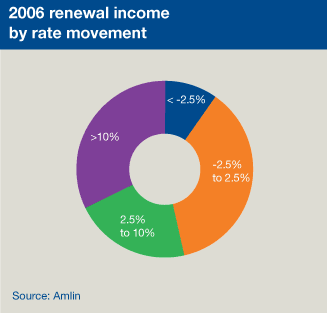Operating & Financial Review
Underwriting – focused on risk and return
|
Shaping the business according to conditions
The combined strengths of Amlin’s diversity and experienced underwriting teams again allowed us to flex the business taking account of market conditions with a view to optimising the risk return relationship.
Against the background of the diverging cyclical pricing patterns, see 2006 market overview. Amlin increased premium income significantly in US catastrophe exposed lines, while reducing it in those areas where prices had fallen to levels where it was becoming more difficult to achieve a satisfactory return for the risk, such as airline and UK commercial insurance. We maintained income in many classes where prices were stable or starting to soften as they continued to offer good margins.
Classes with largest gross premium
Overall, as can be seen below, premium rating conditions were up on 54% of our renewals, broadly flat on 36% and weaker on 10%.

Gross premium written increased 18.5% overall with 77% of 2005 business being renewed and £258 million of new business.
In the Non-marine and reinsurance division, property reinsurance and direct property accounted for £331.3 million, representing 73% of total gross written premium. While £68 million of new business was added in these classes, their combined retention ratio was only 77% reflecting the active repositioning and reduction of Syndicate 2001’s peak catastrophe exposures as described below. The balance of our non-marine portfolio had an average retention ratio of 89% over the year, although it weakened marginally in the latter months with increased competition for some lines.
Offshore energy within our Marine division generated £24.9 million of new business, but with only 59% of 2005 business retained. The account was repositioned to take advantage of significant price increases for Gulf of Mexico risks while bringing modelled potential catastrophe losses down. Although rates for war and terrorism risks have seen continued erosion in 2006, it remains an attractive class and we strengthened our team in this area in the early part of the year which helped grow the account, adding £4.3 million of new business.
We declined approximately 40% of airline renewals as market premium returned to levels close to historic average loss cost, although we successfully sourced some new airline business where we felt the premium better reflected the exposure. Our policy for this sector will be to maintain our involvement in a select portfolio and to protect our peak exposures by purchasing an appropriate reinsurance programme. In other classes, such as airport liability, general aviation and aviation products, where the market remained more firm, we maintained healthy levels of retention whilst selectively adding new business.
The UK commercial portfolio continued to contract as competition for fleet motor, professional indemnity and property package meant we lost business and there were a reduced number of opportunities to write profitable new accounts.2006 was Amlin Bermuda’s first year and the income shown in the table above excludes all business ceded to it by Syndicate 2001.
| Premium changes by business area for 2006 underwriting year (net of brokerage) | |||||||||||||||||||||||||||||||||||||||||||||||||||||||||||||||||||||||||||||||||||||||||||||||||
|
|||||||||||||||||||||||||||||||||||||||||||||||||||||||||||||||||||||||||||||||||||||||||||||||||
